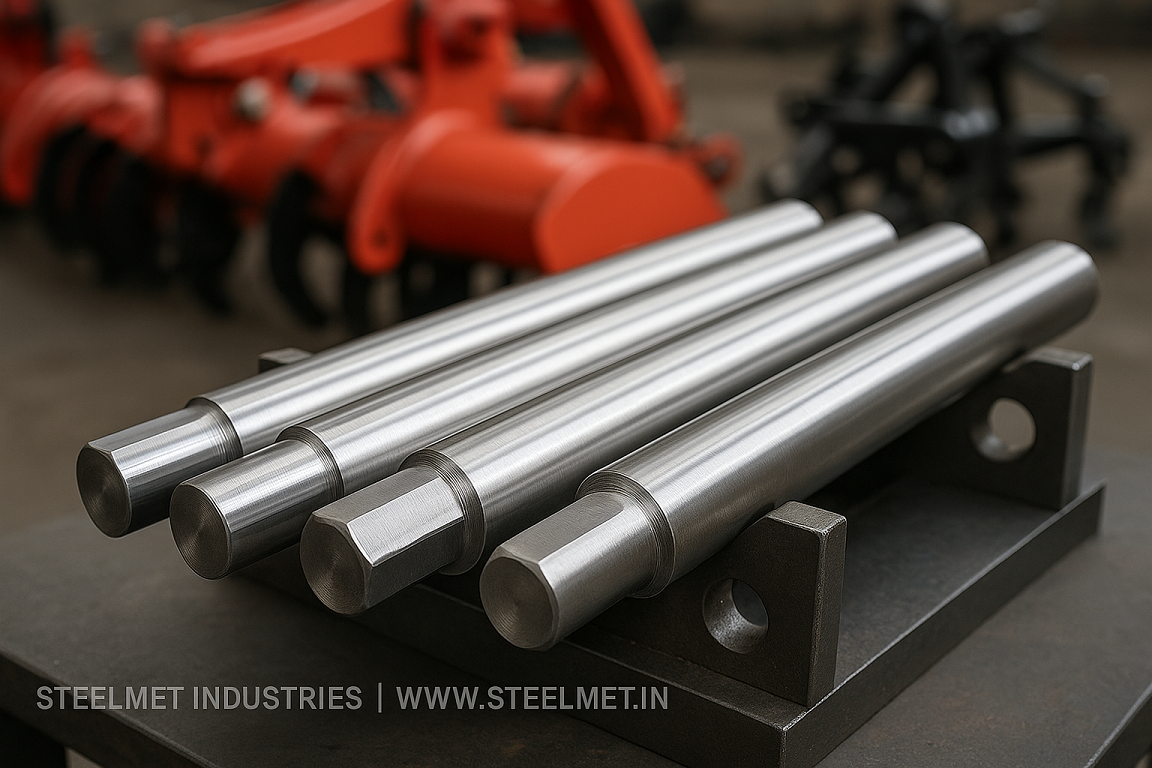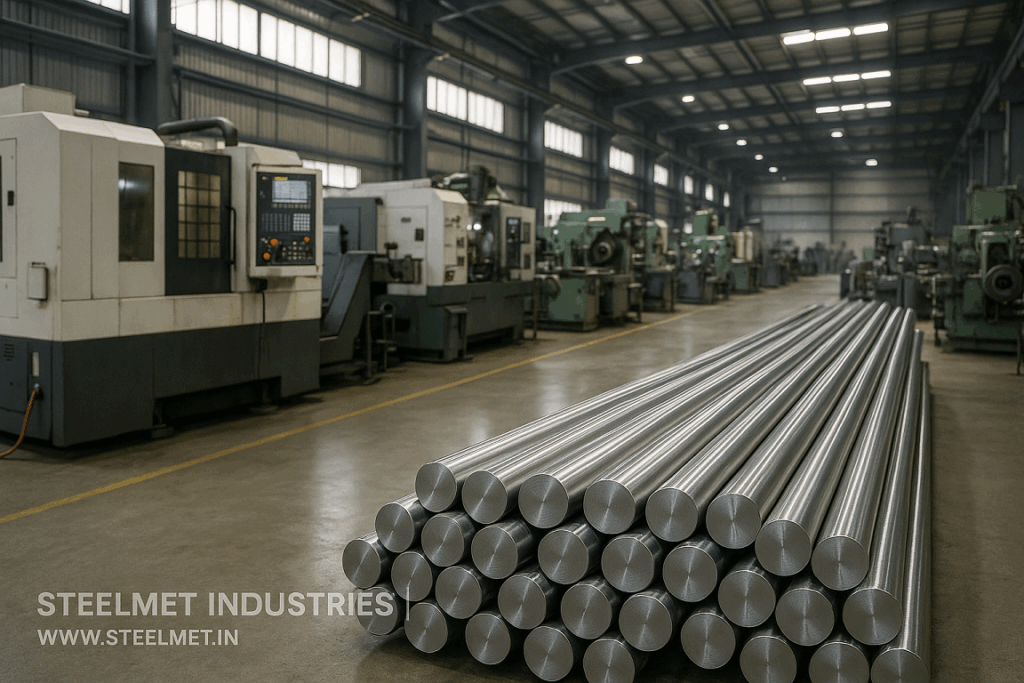Bright Steel Bars for Agricultural Machinery & Equipment
Agricultural machinery components operate in abrasive soil, cyclic impact loads and outdoor conditions. Bright steel bars provide the dimensional accuracy, strength, straightness and machining consistency required for shafts, linkages, pins, rotavator parts, tillage components and high-wear mechanical elements in tractors, implements and farm equipment.

Bright bars prepared for machining into tractor linkage pins, PTO shafts, rotavator flanges and precision farm equipment components.
Applications in Agricultural Machinery
- Tractor linkage pins, hitch pins and drawbar pins
- PTO shafts and transmission shafts
- Rotavator shafts, flanges, brackets and tine holders
- Cultivator shanks, bracket pins and wear components
- Seeder and planter shafts, adjusters and bushings
- Hydraulic lift parts and precision pivot components
- Sprayer pump shafts and agitation components
Component Groups & Child Pages
Tractor Linkage Pins & Hitch Components
Linkage pins constantly experience shock loads and abrasive contamination. Bright bars ensure correct diameter tolerance, stable lock fit and dependable surface hardness after heat treatment or induction hardening.
PTO Shafts & Transmission Components
PTO and transmission shafts require straightness, fatigue strength and strong response to Q&T treatment for extended field operation at varying loads and speeds.
Rotavator Flanges, Shafts & Wear Components
Rotavator components operate in direct soil contact and require both wear resistance and tough core properties. Bright bars support repeatable machining and precise fitment.
Cultivator, Planter & Seeder Components
Cultivator and seeder components demand consistent dimensions and surface finish for reliable field alignment, depth control and corrosion protection.
Hydraulic Lift & Control System Parts
Hydraulic lift rods and control elements require fine surface finish, controlled tolerances and strong fatigue resistance to support repetitive lifting operations.
Why bright bars are preferred for agricultural equipment
- Better OD accuracy improves fitment with bushes and reduces misalignment in linkages.
- Uniform microstructure supports stable heat treatment and repeatable mechanical properties.
- Improved surface finish lowers wear in abrasive field conditions.
- Better straightness prevents bending failures in rotating or load-bearing components.
- Reduced machining allowances lower cycle time and tool wear for mass-produced parts.
Real-world use case
A tractor OEM using EN19 bright bars for 28–42 mm hitch pins and stabilizer rods achieved more consistent hardness after induction hardening. Failures caused by uneven wear reduced significantly, and bush fit issues dropped because of stricter diameter control and improved surface finish.
Quick decision pointers
- For linkage pins and drawbar pins: Use C45/EN8 for standard duty; EN19 for heavy-duty or induction-hardened pins.
- For PTO shafts: Select EN19 or EN24 for fatigue-prone applications at varying loads.
- For rotavator shafts and wear components: Consider EN8D for cost-sensitive parts or EN19/20MnCr5 for higher durability.
- For cultivator and seeder assemblies: Bright C45 or EN8D provide stable machining and fitment for precision agricultural components.
Failure-prevention and quality notes
- Linkage pins must be checked for OD tolerance and surface hardness to avoid bush wear and pin seizure.
- PTO shafts require strict straightness limits to prevent vibration and premature bearing damage.
- Rotavator parts need controlled hardness to balance wear resistance with impact toughness.
- Ensure corrosion protection specifications are included for exposed components.
- Heat-treatment consistency is critical for heavy-duty drawbar pins and stabilizer rods.
Standards & Equivalents (Table 1)
| IS | BS970 | AISI / SAE | DIN / EN | JIS | GOST | GB |
|---|---|---|---|---|---|---|
| C45 | EN8 | 1045 | C45E / 1.1191 | S45C | 45 | 45# |
| EN19 | 708M40 | 4140 | 42CrMo4 / 1.7225 | SCM440 | 40Х | 42CrMo |
| EN24 | 817M40 | 4340 | 34CrNiMo6 / 1.6582 | SNCM447 | 40ХН2МА | 34CrNiMo6 |
| 20MnCr5 | 655M20 | — | 20MnCr5 / 1.7147 | SCM420H | 20ХГ | 20CrMn |
| EN8D / C40 | 080M40 | 1040 | C40 / 1.0511 | S40C | 40 | 40# |
Grade Selection, Performance & Heat Treatment (Table 2)
| Grade | Typical Application in Agricultural Machinery | Performance Indicators | Typical Heat Treatment Route |
|---|---|---|---|
| C45 / EN8 (1045) | Used for linkage pins, hitch pins, shafts and brackets in medium-duty agricultural implements. | Machinability: Medium | Hardenability: Low/Medium | Wear Resistance: Moderate | Fatigue Strength: Moderate | Normalize or Q&T; induction hardening for pin surfaces. |
| EN19 (4140 / 42CrMo4) | Suitable for heavy-duty linkage pins, PTO shafts, rotavator shafts and components needing higher strength and toughness. | Machinability: Medium | Hardenability: Good | Wear Resistance: High | Fatigue Strength: High | Quench & Temper; induction hardening optional for sliding/wear areas. |
| EN24 (4340 / 34CrNiMo6) | Used for high-load PTO shafts, structural rotavator components and parts facing extreme impact or continuous torque cycles. | Machinability: Medium/Low | Hardenability: Excellent | Wear Resistance: Very High | Fatigue Strength: Very High | Q&T with controlled temper sequence; may include cold treatment for high-cycle fatigue applications. |
| 20MnCr5 | Ideal for rotating contact surfaces, splines, shafts and bush-contact areas where a hard wear surface is required with a strong core. | Machinability: Medium | Hardenability: Low (for case) | Wear Resistance: High (after case) | Fatigue Strength: High (core) | Carburize + Q&T; typical farm equipment case depth 0.8–1.2 mm. |
| EN8D / C40 | Used for brackets, mounting components and general-purpose farm equipment parts requiring moderate strength and good machinability. | Machinability: Medium/High | Hardenability: Low | Wear Resistance: Moderate | Fatigue Strength: Low/Moderate | As-drawn or normalized; surface treatment optional. |
Inspection & manufacturing checklist
- Verify OD tolerance and finish for linkage pins; incorrect sizes damage bushes.
- Check straightness for PTO shafts after machining and heat treatment.
- Define hardness and case depth for rotavator pins, splines and wear components.
- For exposed implements, specify rust-prevention coating and storage conditions.
- Request mechanical test certificates for Q&T grades supplied for critical tractor applications.
Frequently Asked Questions
Which steel is most commonly used for agricultural linkage pins?
C45/EN8 is widely used for standard-duty pins; EN19 is selected for heavy-duty or induction-hardened pins.
What material is best for PTO shafts?
EN19 and EN24 are preferred due to their strong fatigue resistance and reliable heat-treatment response.
Are bright bars necessary for rotavator components?
Yes. Bright bars improve dimensional accuracy, reduce machining time and provide a stable base for heat treatment and surface finishing.
Contact for Agricultural Machinery Components
For linkage pins, PTO shafts, rotavator parts or custom components for farm machinery:
Related: Complete guide to bright steel bar applications —
Industrial Machinery —
Heavy Engineering

